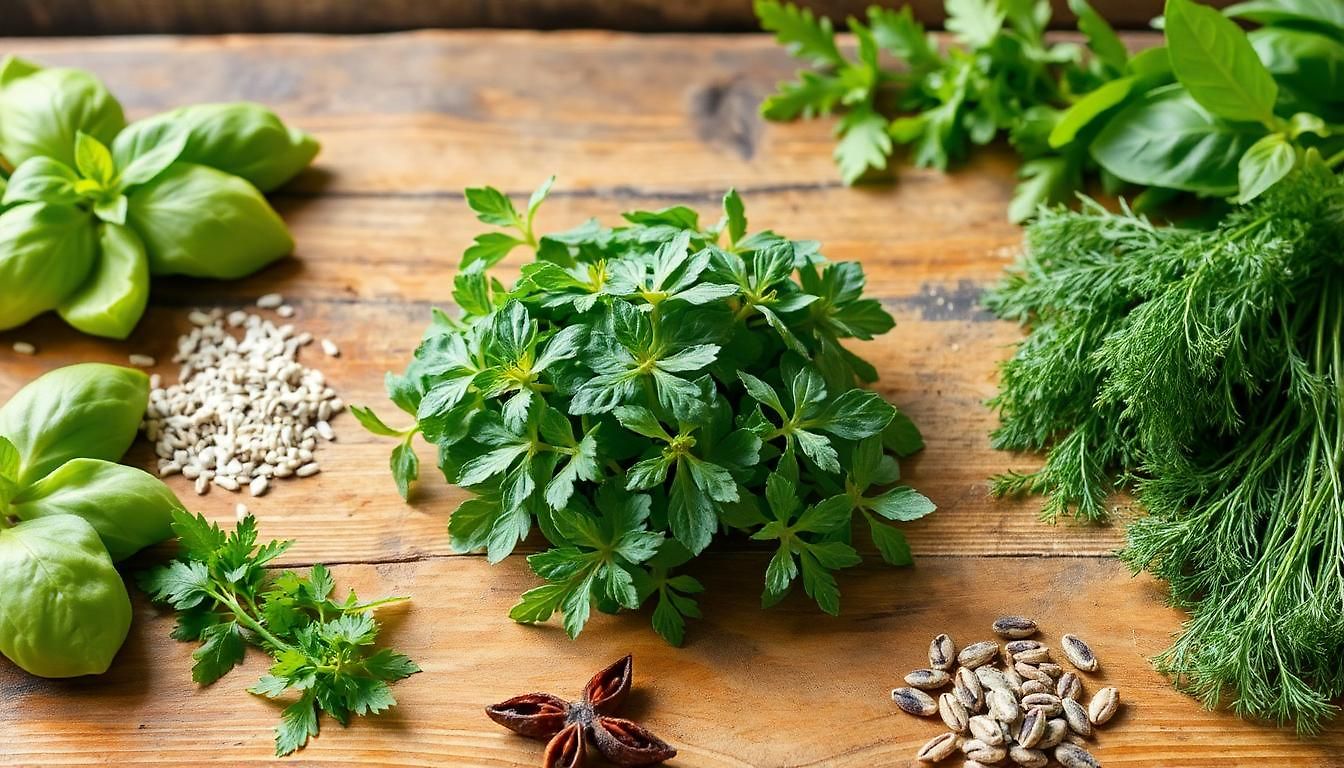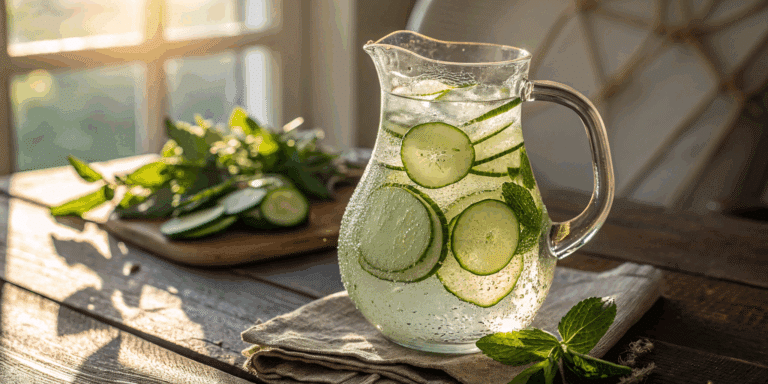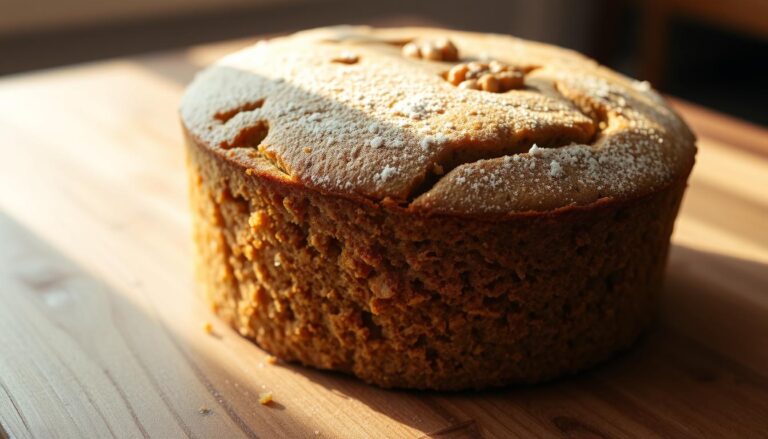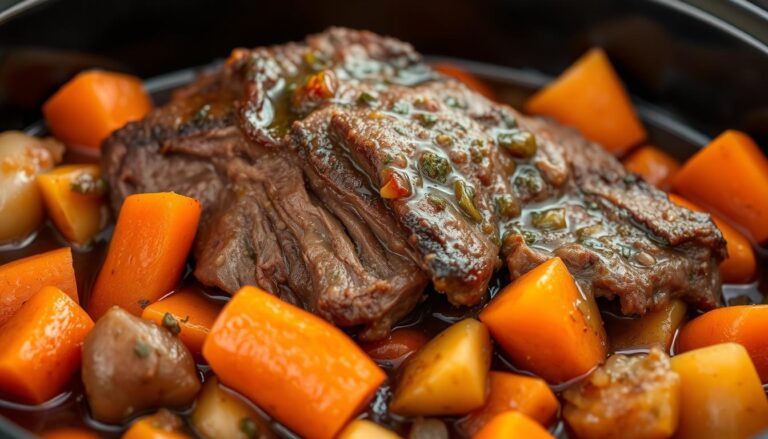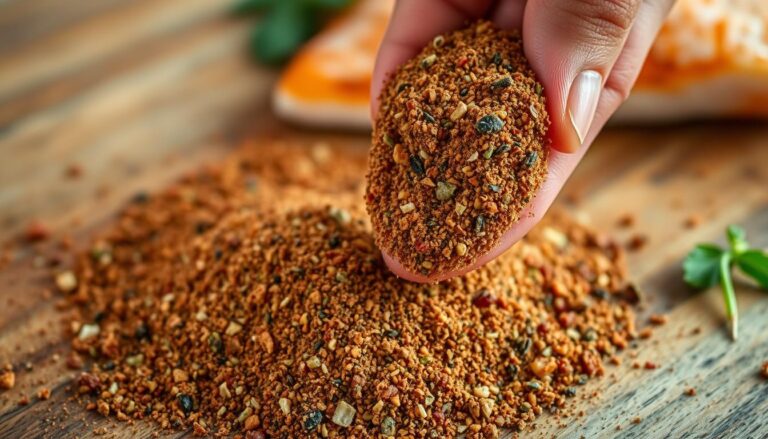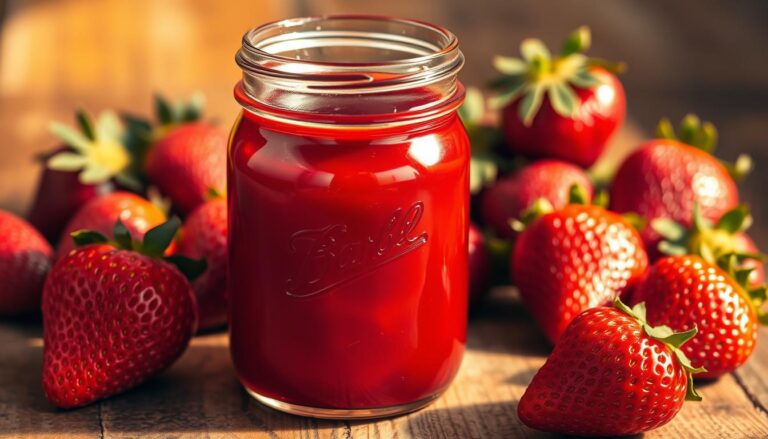The Complete Guide to Tarragon Substitutes: Best Alternatives for Every Recipe
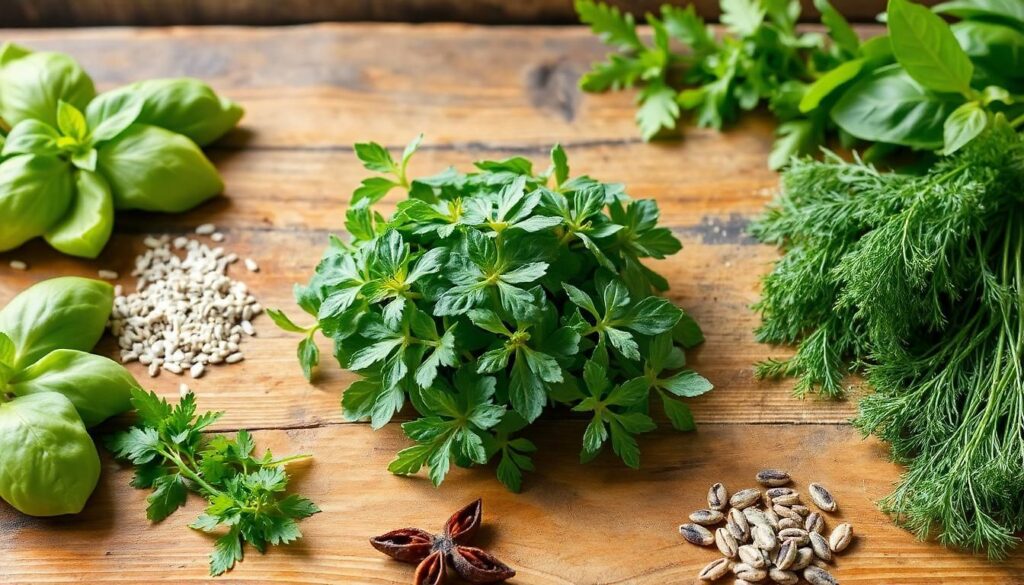
When a recipe calls for tarragon but you don’t have any on hand, don’t worry! This comprehensive guide explores the best tarragon substitutes that can save your dish while maintaining its intended flavor profile. Whether you’re out of this distinctive herb or simply not a fan of its licorice notes, these alternatives will help you create delicious meals without compromising on taste.
Tarragon, known as “the king of herbs” in French cuisine, has a unique flavor profile that combines anise, licorice, mint, and citrus notes. While it may seem irreplaceable, several herbs and spice combinations can effectively stand in for tarragon in most recipes. This article will help you understand what makes tarragon special and how to choose the perfect substitute for your specific cooking needs.
Key Takeaways
- Discover which herbs most closely match tarragon’s distinctive licorice-anise flavor
- Learn the best tarragon substitutes for specific dishes like béarnaise sauce, chicken recipes, and fish preparations
- Understand conversion ratios when substituting fresh tarragon with dried alternatives
- Find options for those who dislike tarragon’s anise flavor but want to maintain herb presence in recipes
- Explore herb combinations that can mimic tarragon’s complex flavor profile
Understanding Tarragon’s Unique Flavor Profile
![Close-up of fresh tarragon leaves – A detailed image showing the slender, glossy green leaves of tarragon with their distinctive shape and texture, highlighting the herb’s elegant appearance.]
Before choosing a substitute, it’s important to understand what makes tarragon so distinctive. This knowledge will help you select the best alternative for your particular recipe.
What Is Tarragon?
Tarragon (Artemisia dracunculus), also known as estragon, is a perennial herb in the sunflower family. It grows throughout North America, Europe, and parts of Asia. The herb features slender, glossy green leaves and is a staple in French cuisine, where it’s considered essential for many classic dishes.
There are primarily two varieties of tarragon:
- French tarragon – The culinary star with the most pronounced flavor and aroma
- Russian tarragon – Less flavorful and generally not preferred for cooking
When recipes call for tarragon, they almost always refer to French tarragon, which has a much more robust flavor profile than its Russian counterpart.
Tarragon’s Distinctive Taste
Tarragon has a complex flavor that makes it uniquely valuable in cooking. Its primary taste characteristics include:
- A dominant anise or licorice flavor
- Subtle hints of mint and vanilla
- Slight citrus notes
- A touch of sweetness balanced with mild bitterness
- Aromatic, herbal undertones
This combination of flavors makes tarragon particularly well-suited for chicken dishes, fish preparations, egg recipes, and creamy sauces. In French cuisine, tarragon is an essential component of béarnaise sauce and the classic herb blend known as fines herbes.
Understanding these flavor components helps in selecting appropriate substitutes that can replicate at least some aspects of tarragon’s unique profile.
Best Overall Tarragon Substitutes
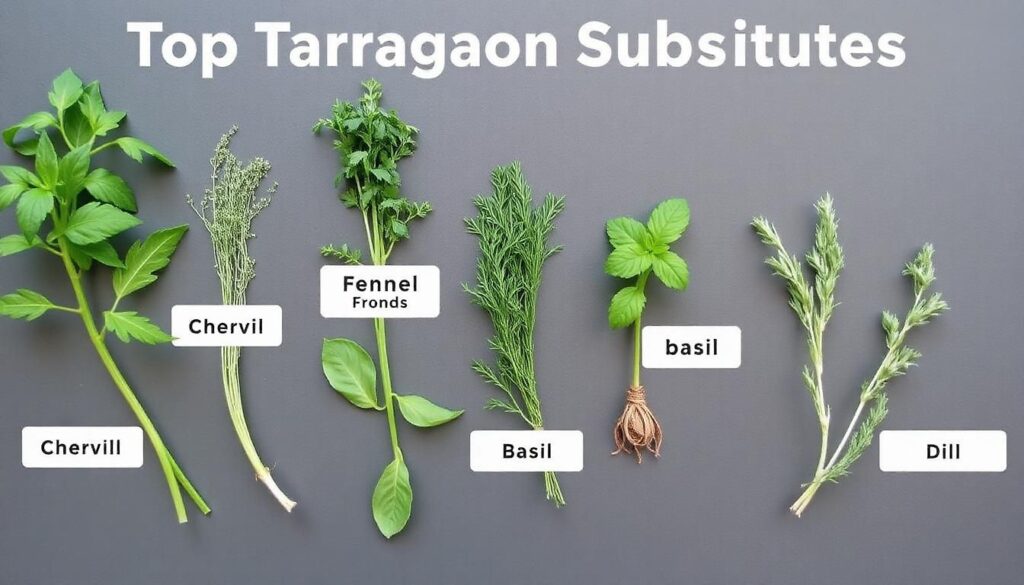
When you need a tarragon replacement, these alternatives offer the closest match to tarragon’s distinctive flavor profile while still being relatively accessible.
1. Chervil
Flavor Similarity: ★★★★★
Chervil stands as the closest substitute to tarragon in terms of flavor profile. Often described as a blend of tarragon, parsley, and chives, chervil delivers a delicate anise flavor that comes closest to mimicking tarragon’s distinctive taste.
Best Used In: Delicate dishes like egg preparations, light sauces (especially béarnaise), and fresh salads.
Substitution Ratio: Use fresh chervil in equal amounts to replace fresh tarragon (1:1 ratio).
Availability: Chervil can be harder to find than other herbs, but it’s worth seeking out for its excellent tarragon-like qualities. Look for it at specialty grocery stores, farmers markets, or grow your own.
2. Fennel Fronds
Flavor Similarity: ★★★★☆
The feathery green tops of the fennel bulb (called fronds) provide an excellent tarragon alternative with their similar licorice flavor. The visual appearance is also somewhat similar to tarragon, making fennel fronds a good aesthetic substitute as well.
Best Used In: Fish dishes, salads, and Mediterranean cuisine.
Substitution Ratio: Use in a 1:1 ratio to replace fresh tarragon.
Pro Tip: When buying fennel bulbs, select ones with abundant fronds attached to maximize your herb yield.
3. Basil (Especially Thai Basil)
Flavor Similarity: ★★★☆☆
While common sweet basil doesn’t have the same licorice notes as tarragon, it can work as a substitute when you need a fresh herb presence. Thai basil, with its more pronounced anise undertones, comes closer to tarragon’s flavor profile.
Best Used In: Pasta dishes, tomato-based recipes, and Mediterranean cuisine.
Substitution Ratio: Use in a 1:1 ratio for fresh herbs.
Availability: Basil is widely available year-round in most grocery stores, making it one of the most accessible tarragon substitutes.
4. Anise Seeds
Flavor Similarity: ★★★★☆
While not a leafy herb like tarragon, anise seeds capture the distinctive licorice flavor that characterizes tarragon. Their potent flavor makes them an excellent addition when you’re looking specifically to replicate tarragon’s anise notes.
Best Used In: Sauces, stews, and recipes where the herb will be cooked for a longer period.
Substitution Ratio: Use very sparingly – about 1/8 teaspoon of anise seeds to replace 1 tablespoon of fresh tarragon.
Pro Tip: Crush the seeds lightly before using to release more flavor.
5. Dill
Flavor Similarity: ★★★☆☆
Dill has a fresh, somewhat sweet flavor that makes it a reasonable substitute for tarragon in many dishes, especially seafood preparations. While it lacks the pronounced licorice notes of tarragon, its bright flavor and similar appearance make it a practical alternative.
Best Used In: Fish dishes, salads, and egg recipes.
Substitution Ratio: Use in a 1:1 ratio when substituting fresh for fresh.
Availability: Dill is widely available in most grocery stores, making it an accessible substitute.
Dried vs. Fresh Tarragon Substitutes
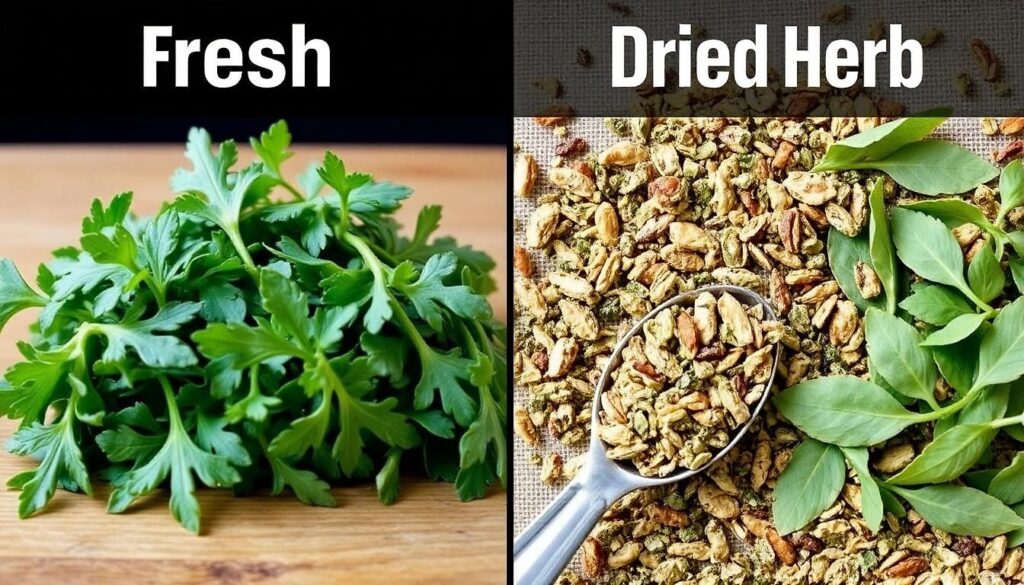
Understanding the differences between fresh and dried herb substitutions is crucial for successful recipe adaptation.
Using Dried Tarragon When Fresh Is Called For
If your recipe calls for fresh tarragon but you only have dried, you can still make the substitution work. Remember that dried herbs are more concentrated in flavor than fresh.
Substitution Ratio: Use 1 teaspoon of dried tarragon for every tablespoon of fresh tarragon called for in the recipe (a 1:3 ratio).
When to Add: Unlike fresh tarragon, which is typically added toward the end of cooking, dried tarragon should be added earlier to allow its flavors to fully infuse into the dish.
Flavor Note: Dried tarragon may be slightly more bitter than fresh, so you might need to balance the flavor with a touch of sweetness in some recipes.
Dried Alternatives to Dried Tarragon
If you don’t have dried tarragon, consider these dried herb substitutes:
- Dried Fines Herbes Blend – Since this French herb mixture contains tarragon, it makes a suitable substitute, though it will add other herb flavors as well.
- Dried Marjoram – With its subtle notes of pine and citrus, dried marjoram can work in a 1:1 ratio as a dried tarragon substitute.
- Dried Oregano – While lacking the anise flavor, dried oregano can provide a strong herbal presence in a 1:1 ratio.
- Herbs de Provence – This French herb blend often contains tarragon and can work well, particularly in French-inspired dishes.
Making Your Own Dried Tarragon Substitute Blend
When no single herb will do, create your own dried herb blend to mimic tarragon’s complex flavor profile:
Basic Dried Tarragon Substitute Blend:
- 1 tablespoon dried basil
- 1 teaspoon dried fennel seeds, crushed
- 1/2 teaspoon dried dill
- 1/4 teaspoon ground black pepper
Use this blend in a 1:1 ratio to replace dried tarragon in recipes.
Substitutes Based on Recipe Type

Different dishes may call for different tarragon substitutes, depending on the role tarragon plays in the recipe.
For Béarnaise Sauce
Béarnaise sauce is perhaps the most tarragon-dependent recipe in French cuisine, making substitution particularly challenging. For the best results:
Best Substitute Option: A combination of fresh chervil and a very small pinch of anise seed or fennel seed.
Alternative Approach: Try this specialty replacement specifically for béarnaise sauce:
- Simmer 1/2 teaspoon ground cinnamon with 1 tablespoon fresh parsley and 1/4 cup water
- Reduce slightly, then use this infusion in place of tarragon in your béarnaise recipe
While not an exact match, this unique combination creates a flavor profile that works well specifically in béarnaise sauce.
For Chicken Dishes
Tarragon and chicken are classic companions in French cooking. When preparing tarragon chicken without tarragon:
Best Substitute Options:
- Equal parts basil and fennel fronds
- Marjoram with a small pinch of anise seed
- Dill (especially when lemon is also in the recipe)
Pro Tip: Adding a splash of white wine vinegar or lemon juice can enhance the herbal substitutes and better mimic tarragon’s bright notes.
For Fish and Seafood Preparations
Fish dishes often benefit from tarragon’s anise notes that complement without overwhelming.
Best Substitute Options:
- Dill (most accessible and commonly paired with fish)
- Fennel fronds (excellent with fatty fish like salmon)
- Chervil (ideal for delicate white fish)
Complementary Addition: A touch of lemon zest helps bridge the flavor gap when using these substitutes in seafood dishes.
For Salads and Vinaigrettes
Fresh tarragon adds distinctive flavor to salads and dressings.
Best Substitute Options:
- Fresh basil (widely available)
- Fresh chervil (most similar flavor)
- A blend of fresh parsley and mint with a tiny pinch of ground fennel seed
Vinegar Tip: If your recipe calls for tarragon vinegar, make a quick substitute by steeping your chosen alternative herb in white wine vinegar for at least 30 minutes before using.
Substitutes for Those Who Don’t Like Tarragon
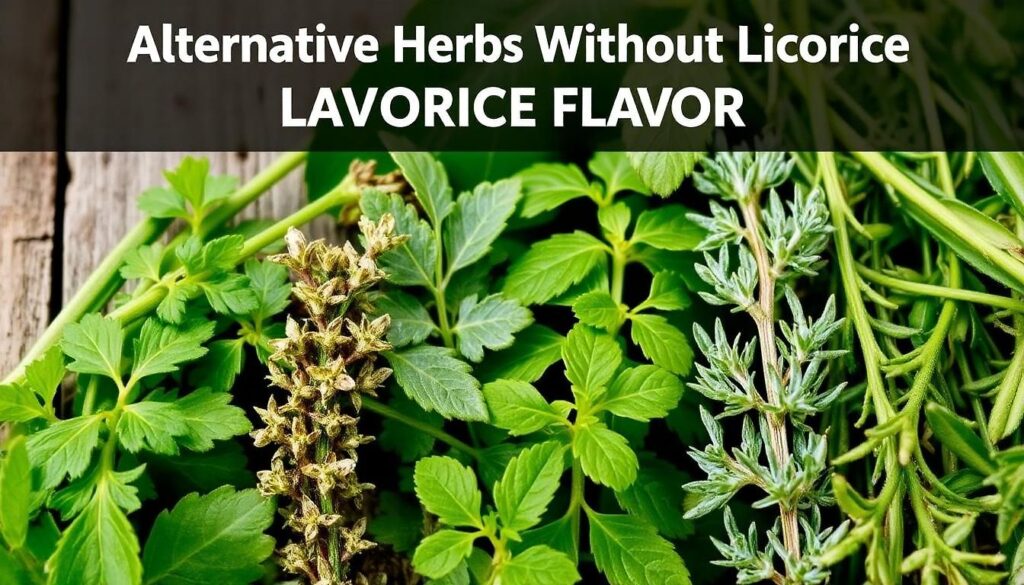
Not everyone enjoys tarragon’s distinctive anise flavor. If you’re looking to avoid the licorice taste but still want to include herbs in your recipe, these alternatives work well.
Fresh Herb Alternatives Without Anise Flavor
These substitutions change the flavor profile but maintain a fresh herb presence:
- Parsley – Clean, bright flavor that works in most dishes
- Thyme – Earthy, slightly floral notes that pair well with chicken and fish
- Marjoram – Subtle citrus and pine notes with a hint of sweetness
- Rosemary (use sparingly) – Strong pine-like flavor, especially good with chicken
Substitution Ratio: Use these herbs in a 1:1 ratio to replace tarragon.
Creating Depth Without Licorice Notes
To create complexity similar to tarragon without the anise flavor:
Herb Blend Without Anise Notes:
- 1 tablespoon fresh parsley
- 1 teaspoon fresh thyme
- 1/2 teaspoon lemon zest
- Pinch of black pepper
This combination provides aromatic complexity without tarragon’s distinctive licorice flavor.
Creative Herb Combinations to Mimic Tarragon
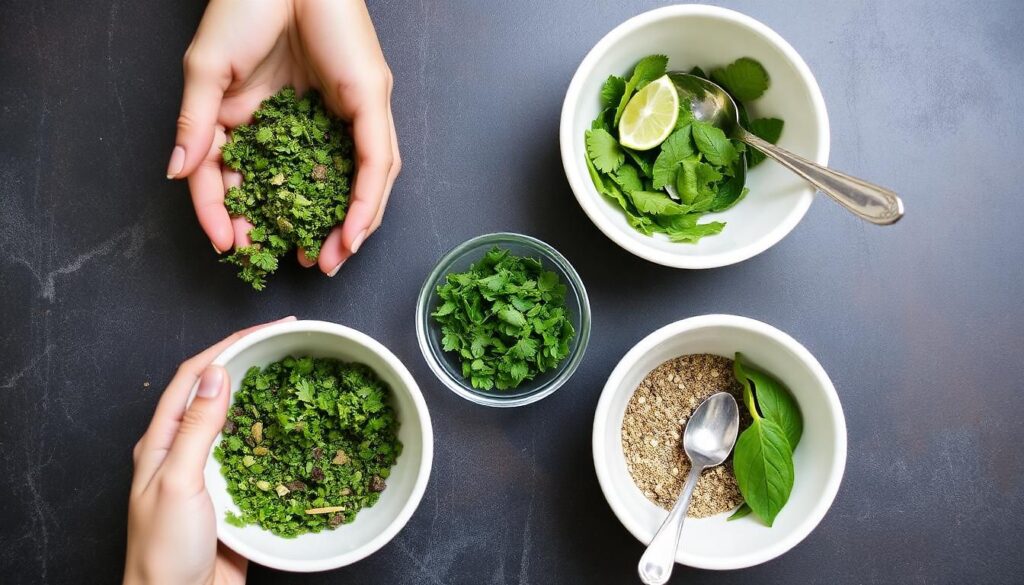
Sometimes, no single herb can replicate tarragon’s complexity. These strategic herb combinations can better mimic tarragon’s multi-faceted flavor profile.
Licorice-Forward Blend
When you want to emphasize tarragon’s anise character:
Ingredients:
- 1 tablespoon fresh basil (preferably Thai basil)
- 1/2 teaspoon fennel fronds, finely chopped
- Pinch of ground anise seed
- Tiny pinch of dried mint
Best For: French sauces, chicken dishes, and fish recipes where tarragon’s licorice notes are essential.
Balanced Herbal Blend
For a more rounded substitute that captures multiple aspects of tarragon’s flavor:
Ingredients:
- 1 teaspoon fresh chervil (if available)
- 1 teaspoon fresh parsley
- 1/2 teaspoon fresh dill
- 1/4 teaspoon lemon zest
- Tiny pinch of ground fennel seed
Best For: Salads, omelets, and lighter dishes where tarragon would provide subtle complexity.
Dried Herb Emergency Blend
When you only have dried herbs on hand:
Ingredients:
- 1/2 teaspoon dried basil
- 1/4 teaspoon dried dill
- 1/8 teaspoon dried marjoram
- Pinch of dried thyme
- Tiniest pinch of ground star anise or fennel (optional)
Best For: Soups, stews, and other long-cooking dishes where the herbs have time to release their flavors.
Conversion Chart for Tarragon Substitutes
| Substitute | For 1 Tbsp Fresh Tarragon | For 1 tsp Dried Tarragon | Best Used In |
|---|---|---|---|
| Chervil | 1 Tbsp fresh | 1 tsp dried | Delicate sauces, eggs, salads |
| Fennel Fronds | 1 Tbsp fresh | N/A (use seeds instead) | Fish, Mediterranean dishes |
| Basil | 1 Tbsp fresh | 1 tsp dried | Tomato dishes, salads, pasta |
| Thai Basil | 2 tsp fresh | 3/4 tsp dried | Asian fusion, stronger flavored dishes |
| Dill | 1 Tbsp fresh | 1 tsp dried | Seafood, salads, eggs |
| Anise Seeds | 1/8 tsp ground | 1/8 tsp ground | Sauces, baked goods |
| Fennel Seeds | 1/4 tsp ground | 1/4 tsp ground | Soups, stews, meat dishes |
| Marjoram | 1 Tbsp fresh | 1 tsp dried | Poultry, vegetables |
| Oregano | 1 tsp fresh | 1/2 tsp dried | Tomato sauces, Mediterranean |
| Parsley + Cinnamon | 1 Tbsp parsley + pinch cinnamon | 1 tsp dried parsley + pinch cinnamon | Béarnaise sauce specifically |
Understanding When Exact Substitution Isn’t Possible
Some iconic tarragon dishes, particularly béarnaise sauce, derive so much of their character from tarragon that substitution will inevitably alter the authentic experience. In these cases, it may be better to:
- Consider a different recipe entirely rather than creating a poor imitation
- Source fresh tarragon online or from specialty stores
- Grow your own tarragon for reliable access (French tarragon doesn’t grow from seed, so purchase a plant)
For dishes where tarragon is less central to the identity of the recipe, the substitutes in this guide will work effectively.
How to Store and Preserve Tarragon for Future Use
To avoid substitution scenarios in the future, consider these methods for preserving tarragon when it’s available:
Freezing Tarragon
Fresh tarragon freezes surprisingly well:
- Wash and dry tarragon sprigs thoroughly
- Remove leaves from stems
- Either:
- Chop and place in ice cube trays with a little water or oil
- Freeze whole leaves on a baking sheet, then transfer to freezer bags
- Frozen tarragon will maintain good flavor for up to 6 months
Making Tarragon Vinegar
Tarragon-infused vinegar can last for months and serves as a convenient way to add tarragon flavor:
- Bruise 1 cup of fresh tarragon leaves
- Place in a sterilized jar
- Cover with 2 cups of white wine vinegar
- Seal and store in a cool, dark place for 2-3 weeks
- Strain out the herbs and rebottle the vinegar
Tarragon Butter
Compound butter with tarragon freezes well and can be used to add instant tarragon flavor:
- Mix 1/2 cup softened butter with 2 tablespoons finely chopped tarragon
- Add 1 teaspoon lemon juice and a pinch of salt
- Roll into a log using parchment paper
- Freeze for up to 3 months
- Slice medallions as needed for recipes
Regional Herb Alternatives to Tarragon
Different culinary traditions have their own herbs that can stand in for tarragon, especially in fusion cooking.
Mediterranean Alternatives
- Basil – The foundation of Italian cuisine works well in place of tarragon, especially in tomato-based dishes.
- Marjoram – Common in Greek cooking, this herb provides a good balance of sweet and savory notes.
Asian Alternatives
- Thai Basil – With its anise notes, Thai basil makes an excellent tarragon substitute in Asian-fusion dishes.
- Shiso (Perilla) – This Japanese herb has complex flavors that can work in place of tarragon in fish dishes and salads.
Eastern European Alternatives
- Dill – Prominent in Eastern European cooking, dill works particularly well in creamy sauces and with fish.
- Lovage – With its celery-like flavor and subtle notes of anise, lovage can substitute for tarragon in soups and stews.
Conclusion
While tarragon’s unique flavor profile makes it irreplaceable in some classic dishes, the substitutes outlined in this guide offer practical alternatives for most cooking situations. Remember these key points when selecting your tarragon substitute:
- For the closest flavor match, chervil and fennel fronds are your best options
- Consider the specific dish when choosing your substitute – what works for chicken may not work for béarnaise sauce
- Don’t be afraid to create herb blends that capture different aspects of tarragon’s complex flavor
- For those who dislike tarragon’s licorice notes, herbs like parsley, thyme, and marjoram can provide aromatic alternatives
By understanding tarragon’s flavor components and how different herbs can approximate them, you can confidently adapt recipes when tarragon isn’t available or desired.
FAQ About Tarragon Substitutes
What is the closest herb to tarragon in flavor?
Chervil is widely considered the closest herb to tarragon in terms of flavor profile, offering a similar but milder anise-like taste. If unavailable, fennel fronds provide the next closest match.
Can I use dried tarragon instead of fresh?
Yes, but reduce the amount. Use 1 teaspoon of dried tarragon for every tablespoon of fresh tarragon called for in recipes (a 1:3 ratio). Remember that dried tarragon has a more concentrated flavor.
What can I substitute for tarragon in béarnaise sauce?
For béarnaise sauce, the best substitute is a combination of fresh chervil and a small pinch of crushed anise seed. Alternatively, a special blend of simmered cinnamon, fresh parsley, and water can create a workable substitute specifically for béarnaise.
Is there a substitute for tarragon that doesn’t taste like licorice?
If you dislike tarragon’s licorice flavor, try herbs like dill, basil, or marjoram, which provide herbal notes without the anise flavor. For chicken dishes specifically, thyme makes an excellent non-licorice alternative.
What’s a good substitute for tarragon vinegar?
To substitute tarragon vinegar, infuse white wine vinegar with your chosen tarragon alternative (basil, dill, or fennel fronds work well) for at least 30 minutes before using. For immediate use, add a pinch of dried tarragon substitute blend directly to plain white wine vinegar.
How can I tell French tarragon from Russian tarragon?
French tarragon has glossier leaves and a stronger anise aroma compared to Russian tarragon. The best test is to crush a leaf between your fingers – French tarragon will have a pronounced licorice scent, while Russian tarragon smells more like grass with minimal anise notes.
What’s a good substitute for tarragon in chicken salad?
For chicken salad, dill makes an excellent tarragon substitute. Its fresh, slightly sweet flavor complements chicken without overpowering other ingredients. Basil or a combination of parsley and a tiny pinch of fennel seed also works well.
Can I grow tarragon at home to avoid substitution issues?
Yes, French tarragon grows well in containers or garden beds in zones 4-9. Unlike many herbs, it cannot be grown from seed, so purchase a small plant from a nursery. With proper care, it will provide fresh tarragon throughout the growing season.

